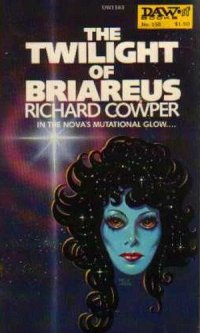In his novel The Twilight of Briareus (John Day, 1974), Richard Cowper, who in reality was John Middleton Murry, Jr., wrote about a fictitious star called Delta Briareus that goes supernova (true, there is no constellation called Briareus, but bear with me). Because it is only 130 light years out, the supernova showers the Earth with radiation, with consequences that are in some cases obvious, in others imaginative in the extreme. It’s a good read, one that at least one critic, Brian Stableford, has compared to J. G. Ballard’s early disaster novels.
The novel contrasts an earthy domesticity with the celestial display that soon shatters it. It’s worth quoting a patch of the book:
It so happened that I, in common, no doubt, with several million others — was among the first in England to observe that ‘majestic effulgence’ within seconds of its arrival. At about twenty past nine on the Tuesday evening I switched off the telly and suggested to Laura that we could do worse than saunter down to The Three Foxes for some fresh air and a gin and tonic. Ten minutes later we were strolling pubwards when she suddenly gripped my arm and yelped: ‘Hey, look at that!’
We stood stock still and gaped up into the heavens.
‘It’s a magnesium flare,’ I said. ‘They used to drop them during the war. There must be some sort of RAF exercise.’
‘Well, why isn’t it moving then?’
‘It is. Only slowly. They have parachutes.’
‘But it’s so bright!’ exclaimed Laura. ‘Look at the shadows it’s given us!’
She was quite right. There on the road beside us were two distinct silhouettes. I contemplated them for a moment and then looked up again. The flare was still there, completely outshining every other thing in the sky with its eye-aching bluish-white brilliance.
And there we are, a supernova in progress, with results no one at this point in the tale can imagine. Cowper, who also wrote as Colin Murry, is a personal favorite. His short story collection Out There Where the Big Ships Go (Pocket Books, 1980) is a good introduction.
Image: The cover of the US paperback of The Twilight of Briareus, the edition I read when it came out.
Supernovae in the Pliocene?
Putting humans under the torch of a supernova makes for exciting fiction, but new work from an international team of researchers now suggests a very real supernova — and probably a series of them — exploded in the Pliocene epoch and later, with evidence of radioactive debris indicating a window between 3.2 to 1.7 million years ago. That would place these events at the boundary between the Pliocene and the Pleistocene (the latter beginning 2.58 million years ago and ending 11,700 years ago).
“We were very surprised that there was debris clearly spread across 1.5 million years,” said team leader Anton Wallner (Australian National University). “It suggests there were a series of supernovae, one after another. It’s an interesting coincidence that they correspond with when the Earth cooled and moved from the Pliocene into the Pleistocene period.”
We’re talking about supernovae no more than 300 light years away, which would make them comparable in brightness to the Moon, and certainly visible during daylight hours. Appearing in Nature, the work argues that iron-60 found in sediment and crust samples from the Pacific, Atlantic and Indian Oceans show Earth’s exposure to cosmic ray bombardment, but at levels that would have been too weak to cause major biological damage, much less extinctions.
The team searched for interstellar dust by examining 120 samples of the ocean floor spanning the past eleven million years. All iron had to be extracted from the ocean cores, work performed at Helmholtz-Zentrum Dresden-Rossendorf (HZDR) in Germany and the University of Tokyo, and the minute amounts of iron-60 had to be separated from terrestrial isotopes using the Heavy Ion Accelerator at ANU. The decay of the radioactive isotopes beryllium-10 and aluminum-26 was used to determine the age of the cores.
Iron-60 itself has a half-life of 2.6 million years, unlike the stable iron-56, and as Wallner explains, is ‘a million-billion times less abundant than the iron that exists naturally on Earth.’ Interestingly, fallout shows up not only in the 3.2 to 1.7 million year window, but also at about 8 million years back. The researchers suggest that the supernovae responsible were probably found in a star cluster that has subsequently moved away from the Earth.
A Writer’s Choice

What would the much closer supernova of the fictional Delta Briareus do to the Earth? In The Twilight of Briareus, the effect is largely meteorological. At first.
The loss of ‘Tiros’ and the rest of the observation satellites hamstrung the world’s long-range weather forecasters, but there was still sufficient evidence of cataclysmic upheaval in the upper atmosphere for a hundred assorted professors to chill humanity’s blood with their doom-laden warnings. These ranged from an ice age at one end of the scale to a slow roasting at the other. The best we could hope for, apparently, was a period of tempests of unprecedented severity. We listened, felt appropriately chastened, and then cheered up again, either from endemic atrophy of the imagination or for no better reason than that the human psyche cannot exist for long on a diet of undiluted pessimism.
There is a compelling lyricism in Cowper’s fiction that eschews irony; in that sense he’s at odds with many of his contemporaries. What an interesting man. He gave up writing of any kind in 1986 and put his effort into painting and antiques, a kind of escape that makes him more akin to William Morris and his circle than, say, Anthony Burgess or Martin Amis (the latter detested his work). I’ve always been taken with Cowper’s elegance, and wonder what he would have done with ancient supernovae blossoming over one of his finely wrought landscapes. If only we knew. Cowper was devastated by the death of his wife Ruth, and died shortly after her in 2002.
Today’s paper is Wallner et al., “Recent near-Earth supernovae probed by global deposition of interstellar radioactive 60Fe,” Nature 532 (07 April 2016), 69-72 (abstract). See also Breitschwerdt et al., “The locations of recent supernovae near the Sun from modelling 60Fe transport,” Nature 532 (07 April 2016), 73-76 (abstract). From the latter:
The Local Bubble of hot, diffuse plasma, in which the Solar System is embedded, originated from 14 to 20 supernovae within a moving group, whose surviving members are now in the Scorpius-Centaurus stellar association7, 8. Here we report calculations of the most probable trajectories and masses of the supernova progenitors, and hence their explosion times and sites.




If we knew a supernovas was ready to go bang locally there are two things we could do to reduce the damage significantly, the moon could be used both to provide an enhanced magnetic field and material to temporarily block high energy radiation. The poles of the moon could be used as the base for these huge magnetic fields to enhance the Earths field slowing particle radiation. And the moons surface material could be ejected towards the supernova radiation over days to block the intense gamma/x-rays if they are produced. Using neutrino detection we could have a small warning, and it is going to be small!
I suppose when we get back to the moon we will be able to detect a lot more SN’s of the past.
I’m not clear what the new information is in the Wallner paper. More observations at better resolution? We’ve known about supernova events from previous 60Fe studies of sediments and rocks, and this paper seems consistent with what is known.
What would be interesting is the more subtle impact of a nearby, but not close, supernova on climate and life. So ignore gross sterilizing gamma ray bursts. Would the effects be directly on Earth, or does the debris subtly affect the sun, increasing or reducing output that in turn affects climate?
A lot of red flags are raised by this site…
Better be forewarned than…
A great post…
Are we able to track the star cluster that contained these supernovae?
I also vaguely remember a SF novel about Sirius B going supernova, how dangerous would that be to Earth?
Sirius A will have to donate an amount of mass to the white dwarf during its death throes, I believe it is not enough to reach the Chandra mass limit but it could create dangerous nova’s.
Supernovas are not dangerous to life, at interstellar distances. The remaining radiation, attenuated by light years of distance, is largely absorbed by the atmosphere, with minor consequences, at most, to surface below. As it says in the article:
It is the creation of nitro oxides that affects the ozone layer that is the dangerous part.
That’s all conjecture, and not that dangerous even if true.